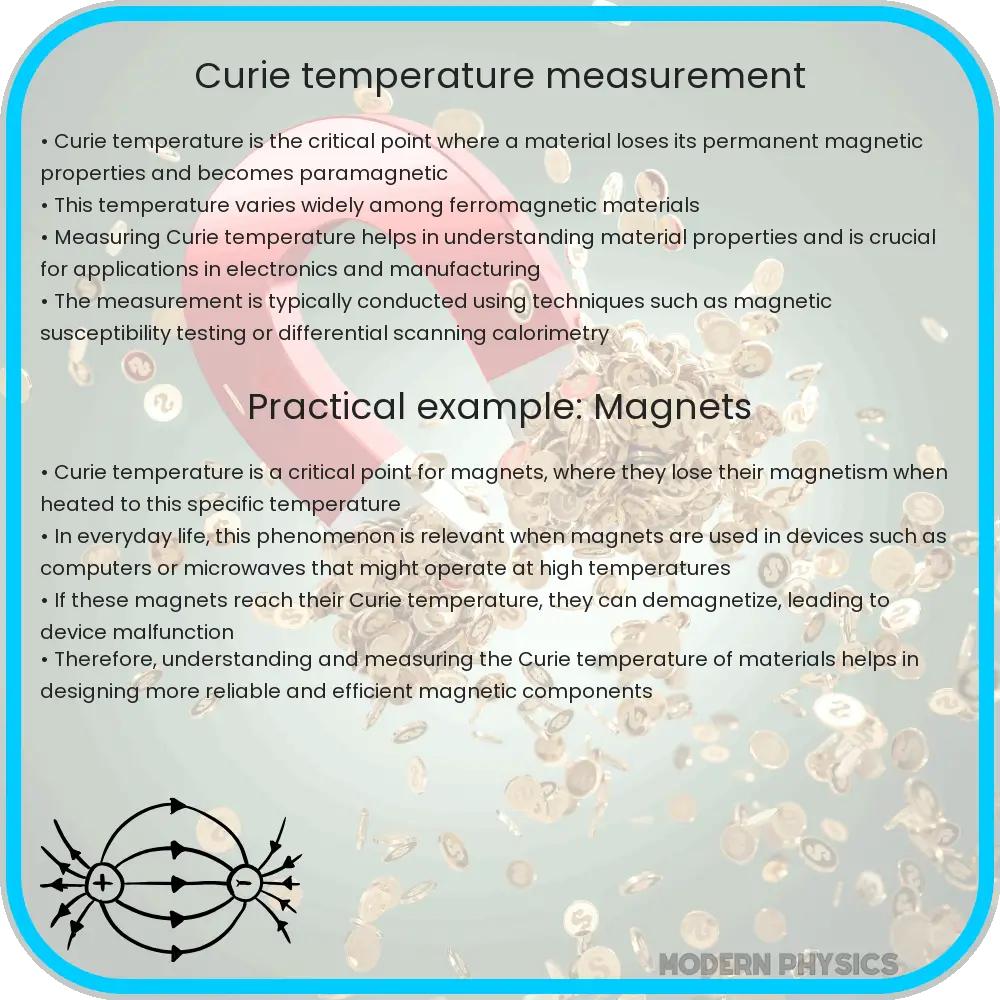Explore the significance, precision methods, and applications of Curie Temperature in magnetic materials for advanced material science research.

Understanding Curie Temperature: Definition and Significance
The concept of Curie Temperature, named after the French physicist Pierre Curie, is a critical aspect in the field of material science and magnetism. It refers to the temperature at which certain materials lose their permanent magnetic properties and become paramagnetic. This temperature is a distinctive characteristic for ferromagnetic and ferrimagnetic materials, like iron (Fe), nickel (Ni), and cobalt (Co).
Precision in Measuring Curie Temperature
Measuring the Curie Temperature with precision is crucial for various applications in materials science and engineering. The accuracy of these measurements can significantly impact the performance and suitability of magnetic materials in different applications. High-precision instruments and techniques are employed to determine this critical temperature, taking into account factors like sample purity, homogeneity, and the external magnetic field strength during the measurement.
Methods of Measuring Curie Temperature
Several techniques are available for measuring the Curie Temperature, each with its advantages and limitations. The most common methods include:
- Magnetic Susceptibility Measurements: This method involves tracking changes in the material’s magnetic susceptibility as the temperature varies. A distinct change in susceptibility indicates the Curie Temperature.
- Differential Scanning Calorimetry (DSC): DSC measures the heat flow into or out of a sample as it is heated or cooled. A peak in the heat flow often corresponds to the Curie Temperature.
- Thermogravimetric Analysis (TGA): TGA measures changes in a material’s weight as it is heated. The weight change near the Curie Temperature can be indicative of the phase transition.
Applications of Curie Temperature
The knowledge of Curie Temperature has vast applications in various fields. Some of the key uses include:
- Material Selection: In designing magnetic devices like hard drives, speakers, and motors, selecting materials with appropriate Curie Temperatures is crucial.
- Temperature Sensing and Control: Materials with known Curie Temperatures can be used in temperature sensors and for thermal cutoff in safety devices.
- Medical and Scientific Research: Understanding the magnetic properties at different temperatures aids in magnetic therapy and research in materials science.
This foundational knowledge of Curie Temperature, its precise measurement, and diverse applications lay the groundwork for advancements in materials science and technology.
Detailed Analysis of Curie Temperature in Various Materials
Different materials exhibit varying Curie Temperatures, which are intrinsic to their atomic and molecular structures. For instance, iron (Fe) has a Curie Temperature of about 1043 K (770°C), while for nickel (Ni), it’s around 631 K (358°C). This variation is crucial in selecting the right material for specific magnetic applications. Special alloys and compounds, such as gadolinium iron garnet (Gd3Fe5O12), have been developed with specific Curie Temperatures for targeted uses.
Challenges in Measuring Curie Temperature
Accurately determining the Curie Temperature is not without challenges. Factors like sample impurities, structural defects, and external magnetic fields can influence the measurement. Advanced techniques and careful sample preparation are essential to mitigate these issues and obtain accurate results.
Future Trends and Research in Curie Temperature Studies
Recent advancements in nanotechnology and material sciences are pushing the boundaries in the study of Curie Temperature. Research is focused on developing materials with tunable magnetic properties and Curie Temperatures for innovative applications in electronics, data storage, and medical technology.
Conclusion
The study and measurement of Curie Temperature play a pivotal role in the realm of material science and magnetic applications. The precision in measuring this critical temperature, understanding its implications in various materials, and overcoming the challenges associated with its determination are fundamental for the advancement of technology. As research continues to evolve, the applications of Curie Temperature will expand, leading to more innovative and efficient magnetic materials and devices. This continual exploration not only enhances our understanding of magnetic phenomena but also opens new avenues in scientific and technological developments.
